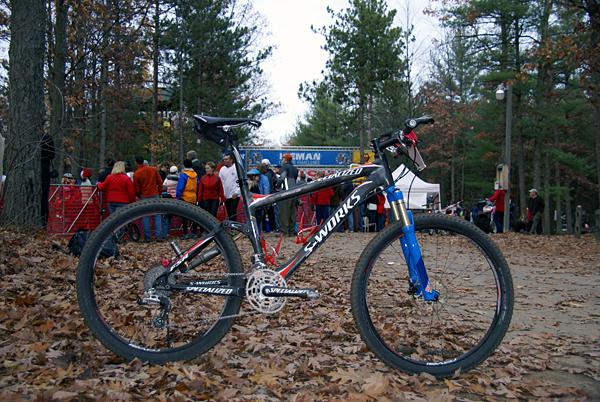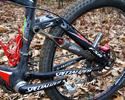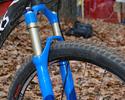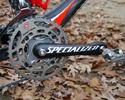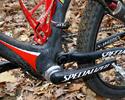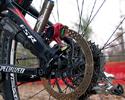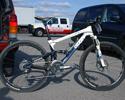
Recently on Cyclingnews.com |
Pro bikes, November 14, 2007
Ned Overend's Specialized S-Works Epic
Cross-country race bike of choice for 'The Lung'By James Huang in Traverse City, Michigan
Living mountain bike legend Ned Overend continues to defy the laws of time. At 52 years of age, the Durango, Colorado resident landed a sixth place finish in the Pro Men field at the Iceman Cometh, an end-of-season 43.5km (27mi) point-to-point classic in northern lower Michigan whose perpetually rolling terrain doesn't particularly cater to the former world champion's strengths. In addition, much of the course is laid out on relatively wide-open doubletrack, paving the way for road race-like speeds and even road race-like tactics, such as double- and single pacelines. "Oh, man [laughs], it started fast," he said. "I mean it was wound up right from the beginning, and there were times when I wasn't on, because I was on the rivet from the gun, and then I finally get back on and started to recover a bit, and then guys were coming off. There were probably about ten of us. Guys would come off, and then I would close the gap. For a while in there, I thought I might have been ok, but then my legs were loaded up. They weren't recovering from all of the speed. The short hills were hurting me; they weren't doing me any good. I thought I might have been better, but the hills weren't long enough. I came off with about five or six miles to go… that was a long five or six miles! [laughs]" Even though Specialized's newest Stumpjumper FSR could easily be called Overend's signature machine, he still chose the more race-oriented Epic for the non-technically demanding terrain. "I don't race the Stumpjumper; I always race the Epic," said Overend. "It's just got more of a race position, more handlebar drop. I still race on flat handlebars and bar ends!" The stock top-end offerings of the Stumpjumper FSR and Epic are nearly identical in weight so it could be argued that shedding grams wasn't much of an additional factor in his choice. However, Overend's Epic was far from stock: the team-only frame wears only minimal cosmetic filler material, no paint at all, and sparse decaling, much like the machines of teammates Liam Killeen and Christophe Sauser. A variety of component selections also shed substantial piles of grams, namely the team-only MTB version of the company's S-Works FACT Carbon integrated crankset (in this case with a trio of elliptical Rotor Q-Rings, Overend's chainring of choice), a NoTubes coated aluminum rear brake rotor, a Carbon-Ti titanium front rotor, and a preproduction version of Rock Shox's new SID Team fork. "I like that SID. I don't have enough rides on it to evaluate it, but I've got some pretty rough rides on it," described Overend. "What I definitely notice on it is that it's stiff. It's not like a [current generation] SID in terms of stiffness [meant as a compliment! Ed.], but I need to put more time in on some rough trails in Durango where I'm familiar with my Reba and the Fox to compare how the action is. But it's light and it's stiff. That part I can feel for sure. That's a Carbon-Ti rotor, and this thing brakes well. It's titanium, so it doesn't save quite as much [weight] as the rear, but the modulation is better on it. It's better than aluminum, but still not quite as good as steel, but for long downhills it's a pretty good setup." Even with Overend's slight build, those rough Durango trails demand a slightly more durable component package than the ultralight builds of Killeen and Sauser. For example, Overend's bike was equipped with aluminum alloy brake caliper and rotor bolts at Sea Otter, but he has since swapped to a more conservative setup. "That was when Benno [Welliet], Christophe's [Sauser] mechanic, set that up. There was some race I did shortly after Sea Otter where I was looking at those bolts before the race [shakes his head]… I just went down to the local shop and replaced them. On those long descents in Colorado, alloy bolts on the brake calipers are kind of sketchy." Those replacement rotor bolts may be steel, but there are still only three of them per rotor. "Yeah, just three rotor bolts; I mean, Eric Carter runs three bolts. I figured if it's good for those guys, it's no problem." While still clearly active on the race circuit, Overend's responsibilities with Specialized extend beyond just racing. "My most structured thing that I do at Specialized is attending product meetings. We have a series of five or six product meetings a year, and the product managers walk the whole product range: every model and everything, and we're already talking about 2010 stuff and beyond. And it's all the product, you know, time trial, road, mountain, city bikes, and then all of the equipment. So product stuff, helping launch stuff to the press and dealers, and signing athletes, and working on their contracts. There's a group of us that work on all of the sponsorship stuff, and even talking about the Euro pro road teams. It's a lot of different stuff." Overend also plays a critical role in introducing that product to media and Specialized's dealer network, in addition to more general roles as an ambassador for the company. "Working for US sales, helping out at the expo for our local shop, getting feedback," he continued. "[The Midwest] is a prime example of an area of the country where racing is really important, and two-niners are really important. It's totally different from somewhere like Colorado. So it's good to get experience in different areas." Naturally, the question of Overend's fitness inevitably arises. After all, one can't help but wonder how someone can manage to maintain that astounding level of fitness so deep into a career. Nevertheless, Overend's approach is surprisingly straightforward. "I'm just kind of doing what I've always done. It changes very slowly; you only get old one day at a time. So I do different little tweaks for my training over the years. But I've never been a big mileage trainer; I've always been more of an intensity kind of guy. I put in some base training in the spring, but not like some other guys. So that kind of lends itself to staying fit for an older guy because it's easier to recover, when you're not doing a big pile of miles all of the time." That all sounds good to us, and who are we to argue? 'Till next time; we have to head out to do some intervals now…
PhotographyFor a thumbnail gallery of these images, click here Images by James Huang/Cyclingnews.com
| |||||||||||||||
Full specificationFrame: Specialized S-Works Epic team-only edition, size M Critical measurements Bottom bracket: Specialized integrated |
Wheelset: Specialized Roval Contrôle XC Race Disc Bars: Specialized S-Works Carbon Fiber 31.8mm XC Flat, with
Specialized C1 Carbon Overendz bar ends Pedals: Shimano SPD PD-M959 Total bike weight: 10.07kg (22.2lb), with computer, without seat pack | ||||||||||||||

